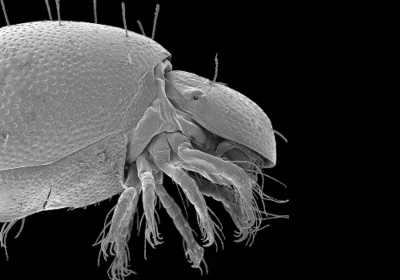Section 7.1
Status of Soil Mites
Ceratozetes cuspidatus
93.2% intact on average
The status of 11 soil mites associated with old deciduous and mixedwood habitat in the Al-Pac FMA area is, on average, 93.2% as measured by the Biodiversity Intactness Index.
This means most of the habitat for old forest soil mites is in good condition, but habitat suitability is lower in some areas due to human development activities.
 Introduction
Introduction
Intactness and sector effects are summarized for soil mite species associated with old deciduous and mixedwood forests in the Al-Pac FMA area and AEI.

Eniochthonius minutissimus
Photo: David Evans Walter

Gymnodamaeus ornatus
Photo: David Evans Walter
Principle 8: Monitoring and Assessment
Criterion 8.2 – Monitoring and evaluating environmental and social impacts of activities carried out in the management unit
FSC Indicator 8.2.3 (3) is supported by providing up-to-date ‘best available information’ on the status of naturally occurring native species from six taxa that can inform on the effectiveness of conservation and restoration actions taken within the FMA over time (linked to FSC Criterion 6.6).
 Results
Results
Intactness of 11 soil mite species associated with old deciduous and mixedwood forests was found to be, on average:
Highlights
- Of the eleven mite species associated with old deciduous and mixedwood forests in the Al-Pac FMA area, intactness was > 90% for all but three species.
- The three species that deviated the most from intact reference conditions were Gymnodamaeus ornatus (81.5%), Oribatella jacoti (82.6%), and Atropacarus striculus (89.9%).
- Habitat suitability for all old forest soil mite species is predicted to have declined between 2010 and 2016 as indicated by the drop in intactness over this time frame, from 94.3% to 93.2%.
- Declines in intactness were less than 3% for all but one mite species—Oribatella jacoti—which went from 89.1% in 2010 to 85.7% in 2016.
- Intactness of old forest soil mites was higher in the Al-Pac FMA area than in the AEI; this can mainly be attributed to the presence of agriculture footprint and energy footprint associated with the surface mineable area in the AEI. These footprint types not only remove old-forest habitat but also disturb the soil to a greater extent than do successional footprint types like forestry, resulting in larger impacts.

Fuscozetes fuscipes
Photo: David Evans Walter
These results have benefited from collaboration between the ABMI and various partners and contributors. More details are available in Collaborators and Contributors.
 Sector Effects
Sector Effects
Local-footprint Sector Effects
To understand which industrial sectors are most impacting soil mite species associated with old deciduous-mixedwood forests in the Al-Pac FMA area, the local-footprint figures show how species' relative abundance is predicted to change within each footprint compared to the habitat it replaced (Figure: Local-footprint Sector Effects).
- With few exceptions, all sectors decrease habitat suitability for soil mite species associated with old deciduous/mixedwood forests in the Al-Pac FMA area because these activities impact their preferred habitat.
- Footprint types that have greater impacts on soil structure, such as agriculture and urban/industrial footprint, tend to have greater impacts than successional footprint like forestry.
- Within forestry footprint, the populations of all old forest soil mite species are predicted to be less abundant than expected, with 7 of the 11 species at least 50% less abundant than expected.
Sector Effects on Regional Soil Mite Populations
The regional population figure shows the predicted change in the total relative abundance of old forest soil mite species across the Al-Pac FMA area due to each sector’s footprint (Figure: Regional Sector Effects).
- Regional effects are much less than local-footprint effects because a great deal of old forest habitat has not been disturbed by anthropogenic activities in the Al-Pac FMA area.
- For transportation, energy and urban/industrial footprint, regional population effects of industrial sectors on soil mites associated with old deciduous forest were small—between -1.8% and +3.2%—because these footprints cover small areas.
- Forestry footprint resulted in the largest predicted changes to suitable habitat for many old forest soil mites—on average -6.6%—because harvesting is the largest footprint type in the FMA area. Four species are predicted to decrease by at least 10% at the regional scale as a result of forestry footprint: Oribatella jacoti (-16.2%), Fuscozetes fuscipes (-11.0%), Gymnodamaeus ornatus (-10.8%), Quatrobelba montana (-10.4%).
To view species-specific sector effects, use the drop-down menu to select a species of interest.
References
Behan-Pelletier, V.M. 1999. Oribatid mite biodiversity in agroecosystems: role for bioindication. Agriculture, Ecosystems and Environment 74(1999):411-423.
McAdams, B.N., S.A. Quideau, M.J.B. Swallow, and L.M. Lumley. 2018. Oribatid mite recovery along a chronosequence of afforested boreal sites following oil sands mining. Forest Ecology and Management 422(2018):281-293.

Atropacarus striculus
Photo: David Evans Walter





